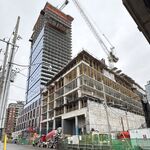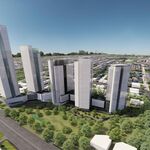afransen
Senior Member
That's not a very compelling argument. If BRT will do, at a fraction of the cost, why not take that route?
While BRT might have the capicity for current transit needs, it won't have that capacity in 20 years. It will be too expensive to replace and too useful to well-used to displace. LRT will be able to handle the density expected on that corridor. Unless of course, you want to spend $2 billion in 2010 dollars on some variety of tunnel.
When I lived in Ottawa in the 1980s, the transitway through downtown didn't work that well. Buses everywhere, stuck in downtown. Lots of complaining, people calling for a tunnel.I'm saying that K-W is the same size now that Ottawa was when it first started to look at BRT vs LRT, and they chose BRT, and it worked.
But if the region has multiple "downtowns", theoretically there would be many more trips than just suburbs to downtown. In a multi-nodal region, would it not make more sense then to build a system that a) has the flexibility to run a number of different routes on the same corridor(s), and b) is cost-effective enough to build the entire region in 1 shot?
You mean this one?I wish I could find that picture of the articulated Ottawa BRT buses wrapped around each other in the middle of winter.

When I lived in Ottawa in the 1980s, the transitway through downtown didn't work that well. Buses everywhere, stuck in downtown. Lots of complaining, people calling for a tunnel.
When did it start working, and how did they achieve that?
That being said though, Ottawa transit usage along the Transitway in the 1980s was far higher than what I've seen in Kitchener through downtown.
I dont know KW and Cambridge well enough to say if this is technically the best choice. But....something about LRT and KW seems right. Its somewhat bold and progressive, for a city its size. But that is also how the city itself comes across and it could set a great precedent for other cities in the country.
I don't doubt you. I'm just wondering when it finally started working, and how did they fix it. How many riders do they move now, compared to the late 1980s. I'm sure you remember all the complaining back then ...With the exception of the downtown portion, the BRT system in Ottawa works really well.
With the exception of the downtown portion, the BRT system in Ottawa works really well.
unless you live within walking distance of the line, it doesn't really benefit you (this is specifically for the K-W case, not for cities like Toronto, where the feeder bus service works really well for trunk lines).
You make it sound like these cities were unique at the time. What city DIDN'T have such service ... well hang on, I'm sure some didn't. But it was relatively normal back then. I'm sure London and Windsor were similar.KW isn't getting rail transit; it's getting it back. And hopefully the fates will bring about the return of a connection to Brantford and new connections to Guelph and Hamilton--both former streetcar cities.
It doesn't have to be a full dedicated ROW, grade-separated BRT in order to be effective in a city the size of K-W, just enough to get the bus out of traffic. Perhaps just some improvements along the Highland/Victoria corridor in Kitchener, and University Ave in Waterloo would be enough.
Having said that, I'm not opposed to the LRT, I think it'll do great things for the city (or cities rather), but I'm just trying to look at alternatives here.
You make it sound like these cities were unique at the time. What city DIDN'T have such service ... well hang on, I'm sure some didn't. But it was relatively normal back then. I'm sure London and Windsor were similar.
Well, I think you and I might agree that the section of the line below Fairview mall should probably not proceed much further than a BRT. South Kitchener is a hodgepodge of low density sprawl separated by vast, insurmountable valleys. Parts of it actually look very suburban American, complete with 70 km/h mini-expressways (e.g. Homer Watson) or really sloppy commercial strips that look like they came straight out of Atlanta (King St. near Sportsworld). Also, Cambridge it suffers from a very scattered distribution of trip generators and, outside of downtown Galt, is not very attractive for redevelopment.




